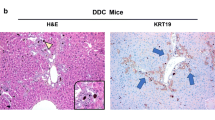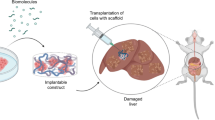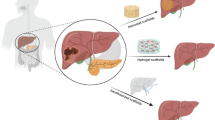Abstract
Integrating carrier drug therapy with recent advances in liver tissue regeneration, this paper proposes a novel nanomedicine-based approach to drug delivery, with the aim of enhancing the regenerative capacity of hepatocytes and improving liver function after partial hepatectomy. The proposed decellularized liver matrix provides excellent biocompatibility and similarity to natural liver components, while the molecules encapsulated in the carrier (tannic acid) promote liver regeneration. In in vitro cultures, the 0.001 mg/mL TA-mPEG-DLM group consistently outperformed the blank group in terms of albumin synthesis: Day 1 (11.1 ± 2.4 vs. 8.2 ± 0.7), Day 3 (5.8 ± 1.3 vs. 4.2 ± 0.4), and Day 5 (1.6 ± 0.3 vs. 1.2 ± 0.2) (μg/100% proliferation rate/well/day). In a liver-injured in vivo model, the 0.5 mg/mL TA-mPEG-DLM group outperformed the blank group in terms of relative liver weight: Day 3 (3.50 ± 0.09% vs. 3.22 ± 0.03%) and Day 7 (4.13 ± 0.21% vs. 3.72 ± 0.06%). Furthermore, the TA-mPEG-DLM group outperformed the blank group in terms of Ki-67 expression in hepatocytes on Day 7 (192.7 ± 34.1% vs. 150.4 ± 11.6%). Taken together, these findings indicate that the proposed drug delivery strategy is a promising approach to liver regeneration following partial hepatectomy with potential for clinical translation.







Similar content being viewed by others
Data and code availability
Data will be made available on request.
References
Sugawara Y, Hibi T (2021) Surgical treatment of hepatocellular carcinoma. Biosci Trends 15(3):138–141
Belghiti J, Kianmanesh R (2005) Surgical treatment of hepatocellular carcinoma. HPB (Oxford) 7(1):42–49
Hou YT, Hsu CC (2020) Development of a 3D porous chitosan/gelatin liver scaffold for a bioartificial liver device. J Biosci Bioeng 129(6):741–748
Bruix J, Sherman M (2005) Management of hepatocellular carcinoma. Hepatology 42(5):1208–1236
European Association For The Study of the Liver (2012) EASL-EORTC clinical practice guidelines management of hepatocellular carcinoma. J Hepatol 56(4):908–943
Yang JD, Hainaut P, Gores GJ, Amadou A, Plymoth A, Roberts LR (2019) A global view of hepatocellular carcinoma: trends, risk, prevention and management. Nat Rev Gastroenterol Hepatol 16(10):589–604
Roayaie S, Jibara G, Tabrizian P, Park JW, Yang J, Yan L, Schwartz M, Han G, Izzo F, Chen M, Blanc JF, Johnson P, Kudo M, Roberts LR, Sherman M (2015) The role of hepatic resection in the treatment of hepatocellular cancer. Hepatology 62(2):440–451
Cieslak KP, Baur O, Verheij J, Bennink RJ, van Gulik TM (2016) Liver function declines with increased age. HPB (Oxford) 18(8):691–696
Dutta R, Mahato RI (2017) Recent advances in hepatocellular carcinoma therapy. Pharmacol Ther 173:106–117
Davis ME, Chen ZG, Shin DM (2008) Nanoparticle therapeutics: an emerging treatment modality for cancer. Nat Rev Drug Discov 7(9):771–782
Chali SP, Ravoo BJ (2020) Polymer Nanocontainers for intracellular delivery. Angew Chem Int Ed Engl 59(8):2962–2972
Aljabali AA, Rezigue M, Alsharedeh RH, Obeid MA, Mishra V, Serrano-Aroca Á, El-Tanani M, Tambuwala MM (2022) Protein-based nanomaterials: a new tool for targeted drug delivery. Ther Deliv 13(6):321–338
Steinmetz NF, Lim S, Sainsbury F (2020) Protein cages and virus-like particles: from fundamental insight to biomimetic therapeutics. Biomater Sci 8(10):2771–2777
Bai X, Su G, Zhai S (2020) Recent advances in nanomedicine for the diagnosis and therapy of liver fibrosis. Nanomaterials (Basel) 10(10):1945
Hawkins MJ, Soon-Shiong P, Desai N (2008) Protein nanoparticles as drug carriers in clinical medicine. Adv Drug Deliv Rev 60(8):876–885
Sedighi M, Mahmoudi Z, Abbaszadeh S, Eskandari MR, Saeinasab M, Sefat F (2023) Nanomedicines for hepatocellular carcinoma therapy: challenges and clinical applications. Mater Today Commun 34:105242
Cordoba-Jover B, Arce-Cerezo A, Ribera J, Pauta M, Oró D, Casals G, Fernández-Varo G, Casals E, Puntes V, Jiménez W, Morales-Ruiz M (2019) Cerium oxide nanoparticles improve liver regeneration after acetaminophen-induced liver injury and partial hepatectomy in rats. J Nanobiotechnology 17(1):112
Hou YT, Wu KCW, Lee CY (2020) Development of glycyrrhizin-conjugated, chitosan-coated, lysine-embedded mesoporous silica nanoparticles for hepatocyte-targeted liver tissue regeneration. Materialia 9:100568
Down JD, White-Scharf ME (2003) Reprogramming immune responses: enabling cellular therapies and regenerative medicine. Stem Cells 21(1):21–32
Munsie MJ, Michalska AE, O’Brien CM, Trounson AO, Pera MF, Mountford PS (2000) Isolation of pluripotent embryonic stem cells from reprogrammed adult mouse somatic cell nuclei. Curr Biol 10(16):989–992
Cetinkunar S, Tokgoz S, Bilgin BC, Erdem H, Aktimur R, Can S, Erol HS, Isgoren A, Sozen S, Polat Y (2015) The effect of silymarin on hepatic regeneration after partial hepatectomy: is silymarin effective in hepatic regeneration? Int J Clin Exp Med 8(2):2578–2585
Abenavoli L, Capasso R, Milic N, Capasso F (2010) Milk thistle in liver diseases: past, present, future. Phytother Res 24(10):1423–1432
Gillessen A, Schmidt HHJ (2020) Silymarin as supportive treatment in liver diseases: a narrative review. Adv Ther 37(4):1279–1301
Geng N, Zheng X, Wu M, Yang L, Li X, Chen J (2019) Tannic acid synergistically enhances the anticancer efficacy of cisplatin on liver cancer cells through mitochondria-mediated apoptosis. Oncol Rep 42(5):2108–2116
Jing W, Chen X, Chen Y, Qin F, Yang H (2022) Pharmacological effects and mechanisms of tannic acid. Biomed Pharmacother 154:113561
Chen PY, Liao YH, Huang WT, Lin YC, Hou YT (2023) Effects of tannic acid on liver function in a small hepatocyte-based detachable microfluidic platform. Biochem Eng J 190:108757
Uygun BE, Soto-Gutierrez A, Yagi H, Izamis ML, Guzzardi MA, Shulman C, Milwid J, Kobayashi N, Tilles A, Berthiaume F, Hertl M, Nahmias Y, Yarmush ML, Uygun K (2010) Organ reengineering through development of a transplantable recellularized liver graft using decellularized liver matrix. Nat Med 16(7):814–820
Hsieh YC, Yin WR, Xu YY, Hou YT (2022) HGF/heparin-immobilized decellularized liver matrices as novel hepatic patches for hepatocyte regeneration in an acute liver injury model. Biochem Eng J 180:108354
Tanaka K, Waki H, Ido Y, Akita S, Yoshida Y, Yoshida T, Matsuo T (1988) Protein and polymer analyses up to m/z 100,000 by laser ionization time-of-flight mass spectrometry. Rapid Commun Mass Spectrom 2(8):151–153
Seglen PO (1976) Preparation of isolated rat liver cells. In: Prescott DM (ed) Methods cell biology. Academic Press, New York, pp 29–83
Suda Y, Sumi M, Sobel M, Ottenbrite RM (1990) Selective labeling of bioactive polysaccharides with a new fluorescent reagent. J Bioact Compat Polym 5(4):412–419
Mitchell C, Willenbring H (2008) A reproducible and well-tolerated method for 2/3 partial hepatectomy in mice. Nat Protoc 3(7):1167–1170
Mitchell C, Willenbring H (2014) Addendum: a reproducible and well-tolerated method for 2/3 partial hepatectomy in mice. Nat Protoc 9(6):1532
Tzirogiannis KN, Kourentzi KT, Zyga S, Papalimneou V, Tsironi M, Grypioti AD, Protopsaltis I, Panidis D, Panoutsopoulos GI (2014) Effect of 5-HT7 receptor blockade on liver regeneration after 60–70% partial hepatectomy. BMC Gastroenterol 14:201
VanSaun MN, Mendonsa AM, Gorden DL (2013) Hepatocellular proliferation correlates with inflammatory cell and cytokine changes in a murine model of nonalchoholic fatty liver disease. PLoS ONE 8(9):e73054
Kumar R, Sripriya R, Balaji S, Kumar MS, Sehgal PK (2011) Physical characterization of succinylated type I collagen by Raman spectra and MALDI-TOF/MS and in vitro evaluation for biomedical applications. J Mol Struct 994(1–3):117–124
Griffith LG, Swartz MA (2006) Capturing complex 3D tissue physiology in vitro. Nat Rev Mol Cell Biol 7(3):211–224
Hall A, Wu LP, Parhamifar L, Moghimi SM (2015) Differential modulation of cellular bioenergetics by Poly(L-lysine)s of different molecular weights. Biomacromol 16(7):2119–2126
Ansari T, Southgate A, Obiri-Yeboa I, Jones LG, Greco K, Olayanju A, Mbundi L, Somasundaram M, Davidson B, Sibbons PD (2020) Development and characterization of a porcine liver scaffold. Stem Cells Dev 29(5):314–326
Asadi H, Rostamizadeh K, Salari D, Hamidi M (2011) Preparation of biodegradable nanoparticles of tri-block PLA-PEG-PLA copolymer and determination of factors controlling the particle size using artificial neural network. J Microencapsul 28(5):406–416
Zhao Z, Lou S, Hu Y, Zhu J, Zhang C (2017) A nano-in-nano polymer–dendrimer nanoparticle-based nanosystem for controlled multidrug delivery. Mol Pharm 14(8):2697–2710
Huang Z, Liao L, McClements DJ, Li J, Li R, Zou Y, Li M, Zhou W (2022) Utilizing protein-polyphenol molecular interactions to prepare moringa seed residue protein/tannic acid pickering stabilizers. LWT 154:112814
Hou YT, Hsu SH, Lee KM (2020) Decellularized liver matrix as substrates for rescue of acute hepatocytes toxicity. J Biomed Mater Res B Appl Biomater 108(4):1592–1602
Chen PY, Hsieh MJ, Liao YH, Lin YC, Hou YT (2021) Liver-on-a-chip platform to study anticancer effect of statin and its metabolites. Biochem Eng J 165:107831
Hou YT, Ijima H, Matsumoto S, Kubo T, Takei T, Sakai S, Kawakami K (2010) Effect of a hepatocyte growth factor/heparin-immobilized collagen system on albumin synthesis and spheroid formation by hepatocytes. J Biosci Bioeng 110(2):208–216
Murata S, Herman P, Lakowicz JR (2001) Texture analysis of fluorescence lifetime images of AT- and GC-rich regions in nuclei. J Histochem Cytochem 49(11):1443–1451
He ZY, Lou KH, Zhao JH, Zhang M, Zhang LC, Li J, Yu HF, Zhang RP, Hu WY (2020) Resina Draconis reduces acute liver injury and promotes liver regeneration after 2/3 partial hepatectomy in mice. Evid Based Complement Altern Med 2020:2305784
Zou Y, Bao Q, Kumar S, Hu M, Wang GY, Dai G (2012) Four waves of hepatocyte proliferation linked with three waves of hepatic fat accumulation during partial hepatectomy-induced liver regeneration. PLoS ONE 7(2):e30675
Kushida M, Kamendulis LM, Peat TJ, Klaunig JE (2011) Dose-related induction of hepatic preneoplastic lesions by diethylnitrosamine in C57BL/6 mice. Toxicol Pathol 39(5):776–786
Buyl K, Kock JD, Bolleyn J, Rogiers V, Vanhaecke T (2015) Measurement of albumin secretion as functionality test in primary hepatocyte cultures. Methods Mol Biol 1250:303–308
Wilson DA (2012) Clinical veterinary advisor: the horse, 1st edn. Elsevier, Amsterdam, pp 934–935
Zhang CC, Zhang CW, Xing H, Wang Y, Liang L, Diao YK, Chen TH, Lau WY, Bie P, Chen ZY, Yang T (2020) Preoperative inversed albumin-to-globulin ratio predicts worse oncologic prognosis following curative hepatectomy for hepatocellular carcinoma. Cancer Manag Res 12:9929–9939
Huang X, Li M, Green DC, Williams DS, Patil AJ, Mann S (2013) Interfacial assembly of protein-polymer nano-conjugates into stimulus-responsive biomimetic protocells. Nat Commun 4:2239
Sahay G, Alakhova DY, Kabanov AV (2010) Endocytosis of nanomedicines. J Control Release 145(3):182–195
Mahapatro A, Singh DK (2011) Biodegradable nanoparticles are excellent vehicle for site directed in-vivo delivery of drugs and vaccines. J Nanobiotechnol 9:55
Papi M, Palmieri V, Maulucci G, Arcovito G, Greco E, Quintiliani G, Fraziano M, Spirito MD (2011) Controlled self assembly of collagen nanoparticle. J Nanopart Res 13(11):6141–6147
Soppimath KS, Aminabhavi TM, Kulkarni AR, Rudzinski WE (2001) Biodegradable polymeric nanoparticles as drug delivery devices. J Control Release 70(1–2):1–20
Rathore P, Arora I, Rastogi S, Akhtar M, Singh S (2020) Collagen nanoparticle-mediated brain silymarin delivery: an approach for treating cerebral ischemia and reperfusion-induced brain injury. Front Neurosci 14:538404
Schrade S, Ritschl L, Süss R, Schilling P, Seidenstuecker M (2020) Gelatin nanoparticles for targeted dual drug release out of alginate-di-aldehyde-gelatin gels. Gels 8(6):365
Rössler B, Kreuter J, Scherer D (1995) Collagen microparticles: preparation and properties. J Microencapsul 12(1):49–57
Fach M, Radi L, Wich PR (2016) Nanoparticle assembly of surface-modified proteins. J Am Chem Soc 138(45):14820–14823
Nghiem THL, Nguyen TT, Fort E, Nguyen TP, Hoang TMN, Nguyen TQ, Tran HN (2012) Capping and in vivo toxicity studies of gold nanoparticles. Adv Nat Sci: Nanosci Nanotechnol 3(1):015002
Yuan Q, Fu Y, Kao WJ, Janigro D, Yang H (2011) Transbuccal delivery of CNS therapeutic nanoparticles: synthesis, characterization, and in vitro permeation studies. ACS Chem Neurosci 2(11):676–683
Kim CH, Sa CK, Goh MS, Lee ES, Kang TH, Yoon HY, Battogtokh G, Ko YT, Choi YW (2018) pH-sensitive PEGylation of RIPL peptide-conjugated nanostructured lipid carriers: design and in vitro evaluation. Int J Nanomed 13:6661–6675
Qin XS, Luo ZG, Peng XC, Lu XX, Zou YX (2018) Fabrication and characterization of quinoa protein nanoparticle-stabilized food-grade pickeing emulsions with ultrasound treatment: effect of ionic strength on the freeze-thaw stability. J Agric Food Chem 66(31):8363–8370
Clogston JD, Patri AK (2011) Zeta potential measurement. Methods Mol Biol 697:63–70
Blanco E, Shen H, Ferrari M (2015) Principles of nanoparticle design for overcoming biological barriers to drug delivery. Nat Biotechnol 33(9):941–951
Rupert S, Selvaraj S, Malayaperumal S, Ramanathan R, Anbalagan C, Satyanesan J, Vennila R, Rajagopal S (2021) Comparison of extracellular matrix (ECM) of normal and d-Galactosamine-induced mice model of liver injury before and after liver decellularization. Regen Eng Transl Med 7:405–415
Lee JS, Shin J, Park HM, Kim YG, Kim BG, Oh JW, Cho SW (2014) Liver extracellular matrix providing dual functions of two-dimensional substrate coating and three-dimensional injectable hydrogel platform for liver tissue engineering. Biomacromol 15(1):206–218
Jaramillo M, Yeh H, Yarmush ML, Uygun BE (2018) Decellularized human liver extracellular matrix (hDLM)-mediated hepatic differentiation of human induced pluripotent stem cells (hIPSCs). J Tissue Eng Regen Med 12(4):e1962–e1973
Sodhi H, Panitch A (2020) Glycosaminoglycans in tissue engineering: a review. Biomolecules 11(1):29
Kim J, Seki E (2023) Hyaluronan in liver fibrosis: basic mechanisms, clinical implications, and therapeutic targets. Hepatol Commun 7(4):e0083
Deegan DB, Zimmerman C, Skardal A, Atala A, Shupe TD (2015) Stiffness of hyaluronic acid gels containing liver extracellular matrix supports human hepatocyte function and alters cell morphology. J Mech Behav Biomed Mater 55:87–103
Wang K, Liu M, Mo R (2020) Polysaccharide-based biomaterials for protein delivery. Med Drug Discov 7:100031
Gough JE, Scotchford CA, Downes S (2002) Cytotoxicity of glutaraldehyde crosslinked collagen/poly(vinyl alcohol) films is by the mechanism of apoptosis. J Biomed Mater Res 61(1):121–130
Kamiloglu S, Sari G, Ozdal T, Capanoglu E (2020) Guidelines for cell viability assays. Food Front 1:332–349
Ruijtenberg S, van den Heuvel S (2016) Coordinating cell proliferation and differentiation: antagonism between cell cycle regulators and cell type-specific gene expression. Cell Cycle 15(2):196–212
Sedlic F, Seiwerth F, Sepac A, Sikiric S, Cindric M, Milavic M, Vuletic LB, Jakopovic M, Seiwerth S (2020) Mitochondrial ROS induce partial dedifferentiation of human mesothelioma via upregulation of NANOG. Antioxidants (Basel) 9(7):606
Michalopoulos GK (2010) Liver regeneration after partial hepatectomy. Am J Pathol 176(1):2–13
Margarson MP, Soni N (1998) Serum albumin: touchstone or totem? Anaesthesia 53(8):789–803
Gong WF, Zhong JH, Lu Z, Zhang QM, Zhang ZY, Chen CZ, Liu X, Ma L, Zhang ZM, Xiang BD, Li LQ (2019) Evaluation of liver regeneration and post-hepatectomy liver failure after hemihepatectomy in patients with hepatocellular carcinoma. Biosci Rep 39(8):BSR20190088
Hsieh HC, Chen YT, Li JM, Chou TY, Chang MF, Huang SC, Tseng TL, Liu CC, Chen SF (2009) Protein profilings in mouse liver regeneration after partial hepatectomy using iTRAQ technology. J Proteome Res 8(2):1004–1013
Acknowledgements
The authors would like to thank National Taiwan University Hospital and National Taiwan University for their financial support (112-UN0076).
Funding
National Taiwan University Hospital and National Taiwan University (112-UN0076).
Author information
Authors and Affiliations
Contributions
Y-CC—Methodology, Investigation, Validation. K-WH—Supervision. Writing—review & editing. Y-HL—Investigation, Validation. W-RY—Investigation, Validation. Y-TH—Supervision, Project administration, Writing—review & editing.
Corresponding author
Ethics declarations
Conflict of interest
The authors declare no competing financial interests for this work.
Ethical approval
The experimental protocol was reviewed and approved by the Ethics Committee on Animal Experiments of National Taiwan University (IACUC Approval No.: NTU-110-EL-00055).
Additional information
Handling Editor: Annela M. Seddon.
Publisher's Note
Springer Nature remains neutral with regard to jurisdictional claims in published maps and institutional affiliations.
Rights and permissions
Springer Nature or its licensor (e.g. a society or other partner) holds exclusive rights to this article under a publishing agreement with the author(s) or other rightsholder(s); author self-archiving of the accepted manuscript version of this article is solely governed by the terms of such publishing agreement and applicable law.
About this article
Cite this article
Chiu, YC., Huang, KW., Lin, YH. et al. Development of a decellularized liver matrix-based nanocarrier for liver regeneration after partial hepatectomy. J Mater Sci 58, 15162–15180 (2023). https://doi.org/10.1007/s10853-023-08971-w
Received:
Accepted:
Published:
Issue Date:
DOI: https://doi.org/10.1007/s10853-023-08971-w




